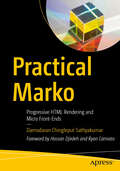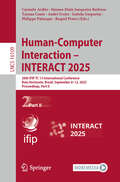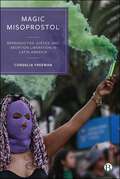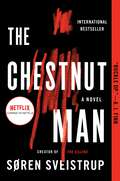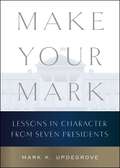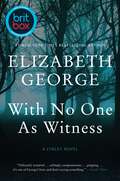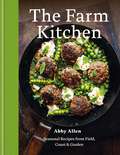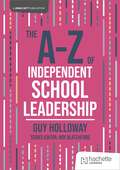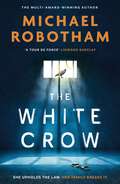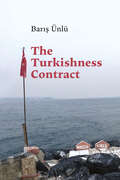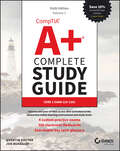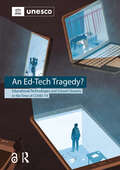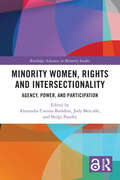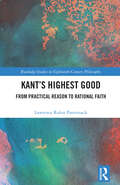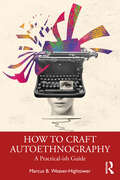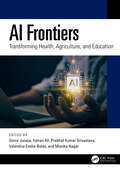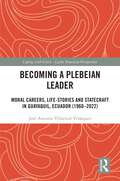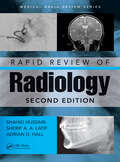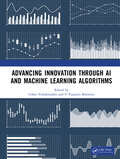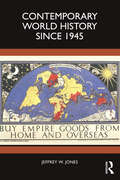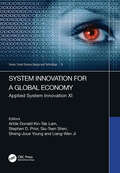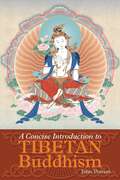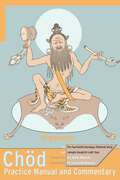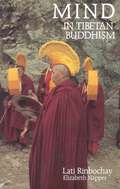- Table View
- List View
Practical Marko: Progressive HTML Rendering and Micro Front-Ends
by Damodaran Chingleput SathyakumarWith the recent evolution of frontend frameworks toward the server, there has been a growing interest in server-side rendering and optimizing for the server to unlock greater performance gains. In this context, this book explores Marko JS—a View framework that is heavily optimized for both the server and the client—and discusses techniques using Marko that can help enterprises achieve significant performance improvements.Focusing on techniques involving Marko, you will learn about topics such as Progressive Rendering, HTML Streaming, server-sent events, and event source APIs. Alongside these techniques, the book will teach you how to accelerate the development of Marko apps quickly and easily using its meta-framework, Marko Run, as well as how to achieve distributed and decoupled applications at scale via server-side micro-frontends that allow for the transclusion of one application into another.A key area of emphasis in the book is the technique of Progressive Rendering, which differs from traditional server-side rendering techniques, where rendering is fully awaited until the entire HTML is generated before being sent. Finally, the book helps you apply these techniques in practical scenarios and teaches you how to build a sample application. By reading this book, you will not only become intimately familiar with high-performance server-side techniques in Marko but also gain expertise in applying these techniques to real-world use cases. What You'll Learn: How to build high performance websites through techniques – Progressive Rendering and HTML Streaming Achieve decoupled and distributed applications via a new paradigm of micro-frontends called micro-frames. Gain familiarity with advanced, efficient server-side rendering techniques for optimizing page load time using Marko, via its meta framework Marko-run. Who is this book for: Web developers, front-end engineers, full stack engineers, programmers
Human-Computer Interaction – INTERACT 2025: 20th IFIP TC 13 International Conference, Belo Horizonte, Brazil, September 8–12, 2025, Proceedings, Part II (Lecture Notes in Computer Science #16109)
by Philippe Palanque Simone Diniz Junqueira Barbosa Carmelo Ardito André Freire Tayana Conte Isabela Gasparini Raquel PratesThis four-volume set LNCS 16108-16111 constitutes the proceedings of the 20th IFIP TC 13 International Conference on Human-Computer Interaction, INTERACT 2025, held in Belo Horizonte, Brazil, during September 8–12, 2025. The 69 full papers, 34 short papers and 79 papers of other types included in this book were carefully reviewed and selected from 330 submissions. They were organized in topical sections as follows: Part I: Accessibility; Adaptive and AI-Powered Learning Systems; Aesthetics in HCI; Affective HCI and Emotion; and Augmented Reality. Part II: Computer-Supported Cooperative Work; Context-Dependent Systems; Design and Evaluation in Smart and Ubiquitous Contexts; Designing for Identity, Safety, and Cultural Values; Emotionally-Informed Design; HCD for Mission-Critical Systems; HCI in Formal and Inclusive Learning Contexts; HCI in Healthcare and Wellbeing; and Human-AI Interaction. Part III: Interaction with Small or Large Displays; Learning Tools and Intelligent Tutoring; Methodologies for HCI; Multimodal Assistive Interfaces; Usability Evaluation Methods; Usable Privacy and Security. Part IV: Courses; Industrial Experiences; Interactive Demonstrations; Panels; Posters; and Workshops.
Magic Misoprostol: Reproductive Justice and Abortion Liberation in Latin America
by Cordelia FreemanAvailable open access digitally under CC-BY-NC-ND licence. How can a stomach ulcer drug transform abortion access? This book tells the story of misoprostol, a medication that was ‘discovered’ as a cheap and safe method for abortion in Latin America. This book develops three conceptual lenses: reproductive justice, mobility politics and geographies of knowledge, to explore the emergence and success of misoprostol for abortions. Chapters cover the experimentation process, activist groups, the challenges of moving the pill in clandestine contexts and how the pill interacts with the law. The book demonstrates how misoprostol, and the people who have mobilized it, have transformed abortion safety, knowledge and practices with global effects.
The Chestnut Man: A Novel
by Soren SveistrupInternational Bestseller • A New York Times Book Review Best Book of the Year • Winner of the Barry Award for Best First Mystery/Crime Novel “A full-throttle thriller in the tradition of classic Stieg Larsson” —A.J. Finn, author of The Woman in the WindowFrom Søren Sveistrup, creator of the hit television show, The Killing—a stylish and atmospheric thriller that follows the race to find a serial killer terrorizing Copenhagen.A psychopath is terrorizing Copenhagen.His calling card is a “chestnut man”—a handmade doll made of matchsticks and two chestnuts—which he leaves at each bloody crime scene.Examining the dolls, forensics makes a shocking discovery—a fingerprint belonging to a young girl, a government minister’s daughter who had been kidnapped and murdered a year ago.A tragic coincidence—or something more twisted?To save innocent lives, a pair of detectives must put aside their differences to piece together the Chestnut Man’s gruesome clues.Because it’s clear that the madman is on a mission that is far from over.And no one is safe.
Make Your Mark: Lessons in Character from Seven Presidents
by Mark K. UpdegroveThe award-wining author of Second Acts and The Last Republicans draws on interviews and conversations with seven presidents to identify the essence of character, leadership and legacy that has defined each of them and the modern American presidency.Throughout his career as an author, journalist, television commentator, and head of a presidential library and foundation, Mark Updegrove has had the privilege of getting to know seven U.S. Presidents, from Gerald Ford to Barack Obama. In Make Your Mark, he offers incisive, compelling sketches of these modern presidents and the character trait that made each suited to his moment in the Oval Office and underlies his most significant accomplishments.Gerald Ford’s instinct to do the right thing in the wake of Watergate;Jimmy Carter’s mission to do good in the areas of peace and human rights during his presidency and throughout his post-presidency;Ronald Reagan’s optimism, restoring the nation’s confidence and pride after a sustained period of demoralizing national setbacks;George H.W. Bush’s humility, helping to ensure a peaceful end to the Cold War that had seethed between the superpowers for over forty years;Bill Clinton’s resilience and determination to keep working for the good of the American people in the face of political and personal obstacles;George W. Bush’s charge to give back as the deadly AIDS epidemic spread unchecked throughout much of the developing world;and Barack Obama’s grace as the first African American to hold the country’s highest office. Make Your Mark reveals that there is no one-size-fits-all model for leadership. We all have our own set of strengths and weaknesses. But drawing on these presidential examples, we can ask ourselves how our character reflects our leadership, and be inspired to find the very best in who we are to make own unique marks as leaders.
With No One As Witness: A Lynley Novel (A Lynley Novel #13)
by Elizabeth GeorgeDon't miss Lynley, a new series now streaming on BritBox!“Delicately textured. . . achingly compassionate. . . gripping. . . . It’s one of George’s best, and that’s saying something.” —Seattle TimesThe #1 New York Times bestselling author’s chilling 13th novel in the Inspector Lynley seriesDetective Inspector Thomas Lynley faces the greatest challenge of his career.When an adolescent boy’s nude body is found draped over a tomb in a graveyard, the police recognize the work of a serial killer who’s been murdering boys in London. This is the killer’s fourth victim but the first to be white.Hoping to avoid charges of institutionalized prejudice in their failure to pursue the earlier crimes to their conclusion, New Scotland Yard takes the case and hands it over to Lynley and his colleagues Detective Constable Barbara Havers and Detective Sergeant Winston Nkata. The killer is a psychopath who does not intend to be stopped. But a devastating tragedy within their ranks causes the police to fumble in their pursuit, which may bring more fatal consequences.
Biology for the IB Diploma Third edition (For the IB Diploma)
by C. J. Clegg Andrew DavisDeveloped in cooperation with the International Baccalaureate®Trust experienced and best-selling authors to navigate the new syllabuses confidently with these coursebooks that implement inquiry-based and conceptually-focused teaching and learning.- Ensure a continuum approach to concept-based learning through active student inquiry; our authors are not only IB Diploma experienced teachers but are also experienced in teaching the IB MYP and have collaborated on our popular MYP by Concept series. - Build the skills and techniques covered in the Tools (Experimental techniques, Technology and Mathematics) with direct links to the relevant parts of the syllabus; these skills also provide the foundation for practical work and internal assessment.- Integrate Theory of Knowledge into your lessons with TOK boxes and Inquiries that provide real-world examples, case studies and questions. The TOK links are written by the author of our bestselling TOK coursebook, John Sprague and Paul Morris, our MYP by Concept series and Physics co-author.- Develop approaches to learning with ATL skills identified and developed with a range of engaging activities with real-world applications. - Explore ethical debates and how scientists work in the 21st century with Nature of Science boxes throughout. - Help build international mindedness by exploring how the exchange of information and ideas across national boundaries has been essential to the progress of science and illustrates the international aspects of science. - Consolidate skills and improve exam performance with short and simple knowledge-checking questions, exam-style questions, and hints to help avoid common mistakes.
The Farm Kitchen: Seasonal Recipes from Field, Coast and Garden
by Abby AllenTaking inspiration from the field, farm, garden and the coast, Abby Allen offers seasonal, sustainable, carefully crafted, wholesome and uncomplicated recipes that celebrate simple, honest ingredients. Chapters are organised by season and include broad bean, pea and sheep's cheese toasts to minted hogget meatballs with peas and goats curd, and New England-style lobster rolls. Filled with common sense, timeless values around the food we grow and eat, each chapter also includes feature essays on key considerations around food and farming in the UK at present, from growing your own to regenerative farming, the seasonality of sheep and food diversity.
The A-Z of Independent School Leadership (John Catt A-Z series)
by Guy HollowayThe A-Z of Independent School Leadership is a guide for school leaders organised around the 26 letters of the alphabet.
The White Crow: The astounding new thriller from the prize-winning author (Philomena McCarthy #2)
by Michael RobothamThe No.1 bestseller and three-time Crime Writers' Award Winner returns with a nail-biting new book. If you loved When You Are Mine or you're hunting for thrillers that make you think and feel, you won't want to miss this.As the daughter of a London crime boss, PC Philomena McCarthy walks a thin blue line keeping the two sides of her complicated life apart.On patrol one night she discovers a child in pyjamas, wandering alone. Taking Daisy home, Phil uncovers the aftermath of a deadly home invasion, as three miles away a prominent jeweller is found strapped to an explosive in his ransacked store.The crimes are linked, and all the evidence points to Phil's father as the mastermind.Phil's two worlds are colliding, trapping her in the middle of a vicious gang war that will threaten her career and everyone she loves.Who can she trust - the badge or her own blood?'Another tour de force from Michael Robotham. He is so good at humanising his characters - even the nasty ones' LINWOOD BARCLAY'Everyone is so beautifully drawn - you tear through the pages hoping they can be trusted' LAINIE ANDERSON'Grips like a vice and twists like a rollercoaster. Impossibly clever. Impossible to put down!' ***** READER REVIEW*STORM CHILD was a No.1 print bestseller in Australia 04.07.24
The Turkishness Contract (Critical Race, Indigeneity, and Relationality)
by Baris ÜnlüThe Turkishness Contract places Critical Race Theory in conversation with literature on Turkey and nation-state making via a historical study enriched by in-depth interviews. In this new English-language edition, Barış Ünlü makes a number of comprehensive changes to his widely read and much discussed 2018 Turkish book, including a new preface and a new sweeping and theoretical introduction. Ünlü uses Critical Race Theory to present a historical–sociological model to examine not only the historical constitution and contemporary functioning of the Turkish nation-state, but also the affective and bodily modalities of being Turkish. He also develops a framework for rethinking the complex relations between the socio-genesis of the Turkish nation and state and the psycho-genesis of the Turkish people, their cognitive habits and emotional orientations, and the structural privileges and unconsciousness strategies of Turkishness. The Turkishness Contract addresses broader theoretical concerns including histories of colonialism, ethnic/racial social contracts, privilege, Armenian Genocide and the Kurdish question, as well as the unraveling of Turkey’s social contract at a moment of contemporary right-wing authoritarianism. In the series Critical Race, Indigeneity, and Relationality
CompTIA A+ Complete Study Guide, 2-Volume Set: Volume 1 Core 1 Exam 220-1201 and Volume 2 Core 2 Exam 220-1202 (Sybex Study Guide)
by Quentin Docter Jon BuhagiarYour complete, accurate resource for the updated CompTIA A+ Core 1 and Core 2 exams In the newly revised sixth edition of CompTIA A+ Complete Study Guide 2-Volume Set: Volume 1 Core 1 Exam 220-1201 and Volume 2 Core 2 Exam 220-1202, you'll discover comprehensive coverage of all A+ certification exam objectives. A team of A+ certified IT professionals with a combined 50 years' experience in the industry walk you through the most popular information technology certification on the market today, preparing you for success on both the 220-1201 and 220-1202 A+ exams. The set emphasizes on-the-job skills you'll use every day as a PC technician or in a related role, with timely updates covering major advances in mobile, cloud, network, and security technology. It walks you through mobile devices, networking, hardware, virtualization and cloud computing, hardware and network troubleshooting, operating systems, security, software troubleshooting, and operational procedures. You'll also find: Practical examples and technology insights drawn from the real-world experiences of current IT professionals Exam highlights, end-of-chapter reviews, and other useful features that help you learn and retain the detailed info contained within Complimentary access to the Sybex online test bank, including hundreds of practice test questions, flashcards, and a searchable key term glossary Prepare smarter and faster, the Sybex way. CompTIA A+ Complete Study Guide 2-Volume Set is perfect for anyone preparing to take the A+ certification exams for the first time, as well as those seeking to renew their A+ certification and PC or hardware technicians interested in upgrading their skillset.
An Ed-Tech Tragedy?: Educational Technologies and School Closures in the Time of COVID-19
by Mark WestThe COVID-19 pandemic pushed education from schools to educational technologies at a pace and scale with no historical precedent. For hundreds of millions of students, formal learning became fully dependent on technology – whether internet-connected digital devices, televisions or radios.An Ed-Tech Tragedy? examines the numerous adverse and unintended consequences of the shift to ed-tech. It documents how technology-first solutions left a global majority of learners behind and details the many ways education was diminished even when technology was available and worked as intended.Using tragedy as a metaphor and borrowing the organization of a three-act theatrical play, the book shows how technology-first modes of learning introduced novel health and safety risks, handed significant control of public education to for-profit companies, expanded invasive digital surveillance and carried detrimental environmental repercussions, in addition to adversely impacting educational access, equity, quality and outcomes in most contexts.Dedicated sections consider alternative and less technology-reliant educational responses to COVID-19 disruptions that had the potential to be more inclusive and equitable. The analysis further explains how pandemic models of learning are rippling beyond school closures and influencing the future of education.Holistically, the work invites readers to reconsider a turbulent chapter in education history and reexamine the purposes and roles of technology in education.
Minority Women, Rights and Intersectionality: Agency, Power, and Participation (Routledge Advances in Minority Studies)
by Alexandra Cosima Budabin, Jody Metcalfe, and Shilpi PandeyThis collection focuses on minority women through the perspectives of minority rights and intersectionality to investigate key concepts such as discrimination, inequality, agency, participation, resistance, and solidarity while also unpacking dynamics of power. It presents diverse grounded empirical cases drawing on field research and data collection while offering a global perspective that explores intersectionality and its effects on minority women ascribed alternately by nationality, religion, ethno-culture, gender, migration background, and race in seven countries as well as in digital and international political spaces. The authors include legal scholars, political scientists, sociologists, and anthropologists who study inequality, minority rights, race and gender issues, and the digital sphere. This interdisciplinary concatenation of authors offers an advantage when working at the junction between intersectionality and minority rights. Interdisciplinary in approach, the book will be of interest to researchers, academics, and policy-makers working in the areas of Human Rights Law, Minority Rights, Gender Studies, Political Science, Social and Cultural Anthropology, and Sociology.
Kant’s Highest Good: From Practical Reason to Rational Faith (Routledge Studies in Eighteenth-Century Philosophy)
by Lawrence Robin PasternackKant’s doctrine of the Highest Good is among the most perplexing and controversial aspects of his practical philosophy. There is widespread disagreement about exactly what the Highest Good is, how Kant argues for it, and what function it is supposed to fulfill. The Highest Good is also situated at the nexus of some of the most acrimonious disputes within Kant scholarship.This book is the first comprehensive, English-language interpretation of the Highest Good’s internal structure, its development, and its place within Kant’s broader philosophical system. Pasternack offers sustained engagement with the contemporary secondary literature on these issues, and discusses key texts of the German Enlightenment which helped to shape Kant’s conception of the Highest Good. He argues that prevailing interpretations rely upon a faulty understanding of the Highest Good, one which has its roots in a number of early interpretive missteps. Pasternack proceeds to discuss how the Highest Good relates to other elements of Kant’s philosophical system, including the conflicting interpretations of his moral psychology, the epistemic strictures of Transcendental Idealism, and how to reconcile his positive philosophy of religion with these strictures.
How to Craft Autoethnography: A Practical-ish Guide
by Marcus B. Weaver-HightowerHow to Craft Autoethnography is a comprehensive and engaging guide to the art and science of autoethnography, a qualitative research method that blends personal narrative with cultural analysis. Designed to be both practical and theoretically grounded, the book offers a structured yet flexible approach to developing "good" autoethnographic research.Throughout the book, Weaver-Hightower addresses the essential components of autoethnographic research, including when to use (or not use) the method, how to generate and analyze data, and how to assess quality and ethics in an autoethnography. The book carefully explores different forms of autoethnography—evocative, analytic, critical, and arts-based—providing readers with concrete examples and exemplars. Practical chapters detail strategies for planning studies, generating data through self-reflection and memory work, engaging with social theory, and writing in ways that resonate with readers both inside and outside academia.This book provides an indispensable resource for students, scholars, and practitioners seeking to deepen their understanding of autoethnography and to use it effectively in their research. The book also includes a range of pedagogical features, such as learning objectives, exercises, and exemplars, to support readers in developing their own autoethnographic projects.
AI Frontiers: Transforming Health, Agriculture, and Education
by Valentina Emilia Balas Prabhat Kumar Srivastava Sonia Juneja Irphan Ali Monika NagarThe rapid advancement of artificial intelligence (AI) is revolutionizing key sectors critical to global progress. AI Frontiers: Transforming Health, Agriculture, and Education delves into how cutting-edge AI innovations are addressing some of the world’s most pressing challenges. This comprehensive volume explores the transformative impact of AI across healthcare, agriculture, and industrial landscapes, offering insights into practical applications, emerging trends, and future opportunities. By blending theoretical foundations with real-world case studies, this book empowers readers with actionable knowledge to leverage AI effectively.What sets this book apart is its interdisciplinary approach, combining technical depth with sector-specific insights. It goes beyond the basics to highlight ethical considerations, data governance frameworks, and sustainable development initiatives. Each chapter presents a roadmap for integrating AI solutions to enhance productivity, efficiency, and decision-making in diverse industries.Key Features: In-depth exploration of AI’s role in healthcare, from predictive analytics in diagnostics to AI-driven drug discovery and personalized treatment strategies. Detailed insights into AI applications in agriculture, including precision farming, crop disease prediction, and resource optimization. Coverage of industrial innovations powered by AI, such as predictive maintenance, process automation, and quality control systems. Case studies illustrating successful AI implementations in real-world scenarios. Discussion of ethical AI deployment, data privacy challenges, and strategies to bridge the digital divide. Forward-looking perspectives on AI’s role in advancing the United Nations’ Sustainable Development Goals (SDGs). This book is an essential resource for researchers, industry professionals, policymakers, and students seeking to understand the transformative power of AI. Whether you are a tech enthusiast, academic, or decision-maker, AI Frontiers offers valuable insights to help you navigate the rapidly evolving landscape of AI-driven innovation.
Becoming a Plebeian Leader: Moral Careers, Life-Stories and Statecraft in Guayaquil, Ecuador (1960-2022) (Coping with Crisis - Latin American Perspectives)
by José Antonio Villarreal VelásquezIn Becoming a Plebeian Leader, José Antonio Villarreal Velásquez examines situations where ordinary women and men become plebeian leaders in urban-popular neighborhoods.Combining oral history, archival research, and ethnography, the book examines plebeian leaders’ moral careers through and within the meaningful and fluctuating connections among urban-popular neighborhoods in the city, and the nation-state from 1960 to the present time. Specifically, Villarreal Velásquez reconstructs, compares, and explains the historical, sociological, and political formation of two plebeian leaders’ moral career paths in Guayaquil (Ecuador); the skills, feelings, and knowledge they acquired to perform their tasks and operate within societal hegemonic frameworks and large-scale structural transformations.Becoming a Plebeian Leader will be of interest to researchers studying urban popular politics in the Global South.
Rapid Review of Radiology (Medical Rapid Review Series)
by Shahid Hussain Sherif Aaron Latif Adrian David HallFollowing the recent release of the new Royal College of Radiology Curriculum, the highly successful text, Rapid Review of Radiology has been updated and expanded to ensure full coverage of the new curriculum. New technologies from the last 10 years have now been included with new interventional procedures. The book contains more than 550 images including Cardiac CT, Radiofrequency Ablation, Nuclear Medicine, Postmortem CT, and Artificial Intelligence. It is of value to radiologists in training and other health professionals wishing to improve their radiological skills and is the second edition of the bestseller for the FRCR Part 2B exam. Key Features: Uses a case-based approach to diagnostic radiology, being remarkably comprehensive. Features very high-quality images, useful for senior radiology trainees and residents preparing for American Board of Radiology and Royal College of Radiology exams. Compiles 200+ cases to help the reader with the practical aspects of image recognition and differential diagnosis.
Advancing Innovation through AI and Machine Learning Algorithms
by V Vijayasri BolisettyThe International Conference on Microstructure, VLSI, Robotics, Communication, Electrical & Emerging Technologies using AI-ML Algorithms (ICMVRCET - 2025) is an essential gathering for those at the forefront of research and development in the fields of Microstructure Design, VLSI systems, Robotics, Communication technologies, and Emerging Electrical systems. This conference seeks to bridge the gap between academic research, industrial advancements, and real-world applications by focusing on the integration of Artificial Intelligence (AI) and Machine Learning (ML) algorithms in these rapidly evolving domains.
Contemporary World History Since 1945
by Jeffrey W. JonesThis book introduces readers to the historical roots of the key events, issues, and themes in the post-World War II period since 1945.Organized by region—Europe, Asia, the Middle East, Africa, and Latin America—it uses case studies to emphasize common themes and patterns. The book argues that the colonial period largely shaped the primary global relationships that still hold in the world today. During and after de-colonization, the Cold War emerged as the dominant global paradigm, but following the collapse of communism, a neo-liberal capitalist agenda prevailed in much of the world, although that has in turn shifted due to the global financial crisis of the late 2000s/early 2010s. The book explores these themes as well as terrorism and the environmental degradation of the planet which are major features of the post-Cold War world, along with racial/ethnic/religious diversity and conflict, democracy, human rights, nationalism, and gender relations.This volume is an essential resource for students of Contemporary World History, the World Since 1945, and the World in the Twentieth Century more broadly.
System Innovation for a Global Economy: Applied System Innovation XI (Smart Science, Design & Technology)
by Stephen D. Prior Siu-Tsen Shen Sheng-Joue Young Liang-Wen Ji Kin-Tak Lam, Artde DonaldSystem Innovation for a Global Economy contains the contribution to the 2025 International Conference on Applied System Innovation (ICASI 2025, Tokyo, Japan, April 22–25, 2025). Of the more than 500 submitted papers from 14 different countries, after review approximately a quarter was accepted for publication. The book aims to provide an integrated communication platform for researchers from a wide range of topics including information technology, communication science, applied mathematics, computer science, advanced material science, and engineering.System Innovation for a Global Economy enhances interdisciplinary collaborations between science and engineering technologists and is aimed at academics and technologists interested in the above-mentioned areas.
A Concise Introduction to Tibetan Buddhism
by John PowersLucid and economical, this introductory text delivers a brisk, fast-moving survey of Tibetan Buddhism. For many years Powers's nearly 600-page Introduction to Tibetan Buddhism has served as the field's most authoritative and comprehensive overview of Tibet's distinctive Buddhist tradition. A Concise Introduction to Tibetan Buddhism explains the core Buddhist doctrines and the practices of meditation and tantra and provides a survey of the four main schools of Tibetan Buddhism.
Chod Practice Manual and Commentary
by Jamgon Kongtrul Thekchok DorjeThis splendid resource for Chöd practitioners contains the Chöd sadhana written by the Fourteenth Karmapa. This daily practice text is given in three versions: Tibetan, a phonetic rendering of the Tibetan, and English translation. Jamgön Kongtrül's commentary on the sadhana supplies necessary amplification and clarification; it is given both in English and Tibetan. An important feature of the commentary is the inclusion of illustrations for the different stages of visualization discussed within the commentary. All in all, this is an essential practice tool and reference guide for the serious Chöd practitioner.
Mind in Tibetan Buddhism
by Elizabeth Napper Lati RinpocheIn the great Tibetan monasteries of Lhasa, monks seeking to purify their minds and develop the understanding necessary for final enlightenment began their inquiry into mind and consciousness by studying The Presentation of Awareness and Knowledge. Through understanding the nature of the mind and the process of cognition, inner peace can be attained. This text, plus Lati Rinbochay's rich and extensive commentary, give a comprehensive explanation of the nature and function of the mind, the different types of mind and mental factors, and how we develop knowledge and understanding. In her, introduction Elizabeth Napper gives an overview of the principal divisions of consciousness and mind.
